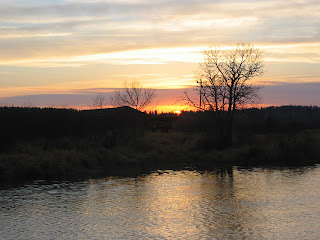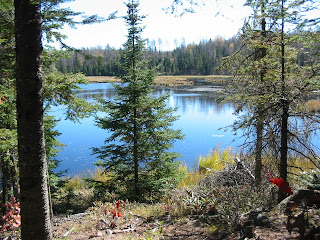Up until this point, Wayne has been out in the woods recovering existing corner monuments. The problem with recovering corners on a project like this is you have to get there first. The fact that the southern 4 sections on this project are inaccessible via ATV's has made this project interesting. These 4 sections are essential since they may affect the corner positions on the rest of the project.
Until today, most of the corners in this area have been a 3 mile hike, one way. Wayne has been hiking in to search for every corner. This is no easy feat. To search for a corner you need some basic gear including, but not limited to:
- Field Notes
- GPS Receivers
- Ribbon
- Machetes
- Maps
- Lath
- Food
- Water
Just think, 3 miles carrying all this gear just to find 1 corner. You may be able to find a couple of corners a day, but in the end, you have to come out and do it all over again the next day.
Once the corner is found or re-established we have to either reset or maintain the corner. To do this add the following to what we need to pack in:
- More Water
- More Food
- Monuments
- Tree Tags
- Chainsaws
- Fence Posts
- Signs
- Fence Post Driver
There is one line that will require approximately 8 fence posts in a span of 2 miles. Think of carrying 8 fence posts for 3 miles through heavy brush, swamp and buckthorn to get to the first corner. We had to find a better way in.
Our optimal access is when we can utilize ATV's. As I said, these four sections are virtually inaccessible. To get to the area, we need to cross the Vermillion river in canoes, hike 3/4 of a mile, then cross through a swamp which has a creek running through the middle of it.
So one day a couple of weeks ago Wayne was searching for a corner in this area and all of the sudden a ATV came running up behind him. This guy had figured out how to cross the river, cross the swamp and get into the area that we thought was inaccessible.
It turns out that some bear hunters that have figured out a way to float the ATV's across the Vermillion River on a jon boat. They load the ATV's on a flat bottomed boat and balance it very carefully to get it across the river.
So, problem 1 solved.
We then proceeded to search for where they were crossing the small creek. It was easy enough, just follow the tracks and there it was. They had laid down a bunch of deadfall to cross in a narrow point of the creek.
Problem 2 solved, we can cross the creek.
Now it was just a matter of figuring out how to get everywhere else. Wayne went to maintain a corner and I went to figure out how to get around on the ATV's.
When we met back at the canoe, the corner was maintained and we figured out how to turn a 3 mile hike into a 500 foot hike.




















